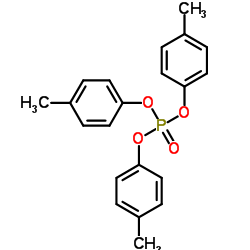Tris(4-methylphenyl) phosphate

Tris(4-methylphenyl) phosphate structure
|
Common Name | Tris(4-methylphenyl) phosphate | ||
|---|---|---|---|---|
| CAS Number | 1330-78-5 | Molecular Weight | 368.363 | |
| Density | 1.2±0.1 g/cm3 | Boiling Point | 438.5±44.0 °C at 760 mmHg | |
| Molecular Formula | C63H63O12P3 | Melting Point | -33ºC | |
| MSDS | Chinese USA | Flash Point | 232.4±48.8 °C | |
| Symbol |


GHS08, GHS09 |
Signal Word | Warning | |
|
Fungal recognition enhances mannose receptor shedding through dectin-1 engagement.
J. Biol. Chem. 286(10) , 7822-9, (2011) The mannose receptor (MR) is an endocytic type I membrane molecule with a broad ligand specificity that is involved in both hemostasis and pathogen recognition. Membrane-anchored MR is cleaved by a metalloproteinase into functional soluble MR (sMR) composed o... |
|
|
Uranium-sensitive electrodes based on the uranium-di(octylphenyl)phosphate complex as sensor and alkyl phosphate as mediator in a PVC matrix membrane.
Talanta 36(6) , 672-4, (1989) The properties of uranium-sensitive electrodes based on membranes containing uranium di-(4-octylphenyl)phosphate as sensor have been determined, in presence of different phosphates as mediators. The electrode prepared from tritolyl phosphate as mediator was f... |
|
|
Induction of autophagy in human neuroblastoma SH-SY5Y cells by tri-ortho-cresyl phosphate.
Mol. Cell Biochem. 396(1-2) , 33-40, (2014) Tri-ortho-cresyl phosphate (TOCP) is an organophosphorus ester and has been widely used in industry. It is found that TOCP induced delayed neurotoxicity in humans and sensitive animal species. However, the mechanism of TOCP-induced neural cytotoxicity remains... |
|
|
Apelin-13 Prevents the Delayed Neuropathy Induced by Tri-ortho-cresyl Phosphate Through Regulation the Autophagy Flux in Hens.
Neurochem. Res. 40 , 2374-82, (2015) Organophosphate-induced delayed neuropathy (OPIDN) is pathologically characterized by the swollen axon containing aggregations of microtubules, neurofilaments, smooth endoplasmic reticulum and multivesicular vesicles. At present, the exact mechanism of OPIDN ... |